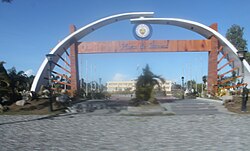Bansud
Bansud | |
|---|---|
| Municipality of Bansud | |
 Municipal grounds | |
 Map of Oriental Mindoro with Bansud highlighted | |
Location within the Philippines | |
| Coordinates: 12°51′34″N 121°27′24″E / 12.8594°N 121.4567°E | |
| Country | |
| Region | Mimaropa |
| Province | Oriental Mindoro |
| District | 2nd district |
| Barangays | 13 (see Barangays) |
| Government | |
| • Type | Sangguniang Bayan |
| • Mayor | Ronaldo Mortel Morada |
| • Electorate | 26,983 voters (2022) |
| Area | |
| • Total | 343.47 km2 (132.61 sq mi) |
| Population (2020 census)[3] | |
| • Total | 42,671 |
| • Density | 120/km2 (320/sq mi) |
| Time zone | UTC+8 (PST) |
| ZIP code | 5210 |
| PSGC | |
| IDD : area code | +63 (0)43 |
| Income class | 2nd municipal income class |
| Revenue (₱) | ₱ 200.6 million (2020) |
| Native languages | Romblomanon Tagalog |
| Website | www |
Bansud, officially the Municipality of Bansud, is a 2nd class municipality in the province of Oriental Mindoro, Philippines. According to the 2020 census, it has a population of 42,671 people.[3]
Bansud is 90 kilometres (56 mi) from Calapan.
Barangays
Bansud is politically subdivided into 13 barangays.
| Barangay | Population (2016) |
|---|---|
| Alcadesma | 2,184 |
| Bato | 842 |
| Conrazon | 4,105 |
| Malo | 1,875 |
| Manihala | 1,063 |
| Pag-Asa | 3,193 |
| Poblacion | 6,891 |
| Proper Bansud | 3,337 |
| Rosacara | 2,280 |
| Salcedo | 5,135 |
| Sumagui | 3,014 |
| Proper Tiguisan | 2,347 |
| Villa Pag-asa | 4,726 |
| Total | 40,992 |
Etymology
The name of the town is said to be derived from a legend. The legend says that long ago the Mangyans, the aborigines of the Mindoro settled in the lands near the mouth of Bansud River, which they called “Basud” which means Delta. The delta provided fertile soil for the people; hence they lived there peacefully and productively until the time that settlers from the province of Marinduque and Visayan Islands moved in. In many years that followed, the word “Basud” was eventually changed to Bansud.
Demographics
| Year | Pop. | ±% p.a. |
|---|---|---|
| 1960 | 10,935 | — |
| 1970 | 17,492 | +4.80% |
| 1975 | 20,095 | +2.82% |
| 1980 | 22,614 | +2.39% |
| 1990 | 26,225 | +1.49% |
| 1995 | 31,901 | +3.74% |
| 2000 | 35,032 | +2.03% |
| 2007 | 35,664 | +0.25% |
| 2010 | 38,341 | +2.67% |
| 2015 | 40,992 | +1.28% |
| Source: Philippine Statistics Authority[4][5][6][7] | ||
References
- ^ Municipality of Bansud | (DILG)
- ^ "Province: Oriental Mindoro". PSGC Interactive. Quezon City, Philippines: Philippine Statistics Authority. Retrieved 12 November 2016.
- ^ a b Census of Population (2020). "Mimaropa". Total Population by Province, City, Municipality and Barangay. Philippine Statistics Authority. Retrieved 8 July 2021.
- ^ Census of Population (2015). "Region IV-B (Mimaropa)". Total Population by Province, City, Municipality and Barangay. Philippine Statistics Authority. Retrieved 20 June 2016.
- ^ Census of Population and Housing (2010). "Region IV-B (Mimaropa)" (PDF). Total Population by Province, City, Municipality and Barangay. National Statistics Office. Retrieved 29 June 2016.
- ^ Censuses of Population (1903–2007). "Region IV-B (Mimaropa)". Table 1. Population Enumerated in Various Censuses by Province/Highly Urbanized City: 1903 to 2007. National Statistics Office.
{{cite encyclopedia}}: CS1 maint: numeric names: authors list (link) - ^ "Province of Oriental Mindoro". Municipality Population Data. Local Water Utilities Administration Research Division. Retrieved 17 December 2016.


